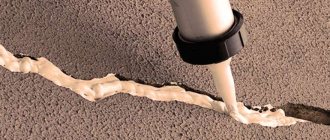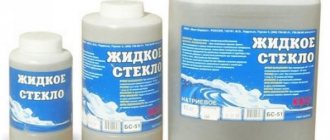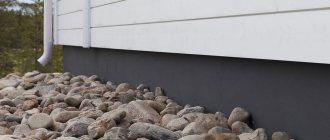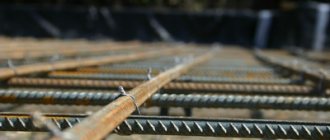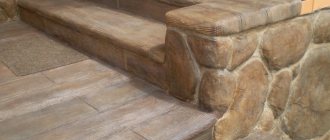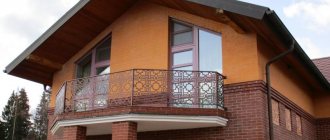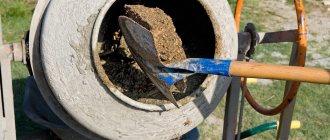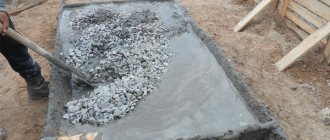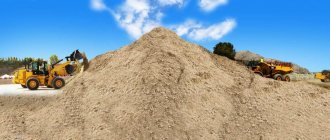The presence of cracks in concrete indicates problems with the pouring. We will try to figure out why concrete is cracking and how serious the damage is. Cracks in concrete always appear, even in new buildings. Splitting of concrete occurs due to violation of technology or proportions during the production of the solution, or age. The formation of cracks negatively affects the load-bearing capacity of the walls, but the problem cannot be completely avoided. You should monitor the width of the cracks formed and eliminate them in a timely manner.
Causes of concrete cracking after pouring
A clear sequence of design and manufacture of monolithic foundations is given in the regulatory documents SP 20.13330 - SP 25.13330, departmental standards of the VSN, technical maps of the TTK. However, mixtures, formwork and reinforcing frames are often made at home in violation of technology, proper care of the concrete is not provided, and the geological conditions in the construction site are ignored.
The main reasons why concrete cracks after pouring are violations of technology, operation, structural design and even the choice of materials.
Separation of cracks into groups
Determining why concrete cracks when drying is necessary in order to select the most appropriate method for eliminating defects that have arisen.
Constructive
If significant cracks appear in the concrete after pouring, this may be due to serious errors in design calculations. These are dangerous defects that reduce the strength characteristics of a building or structure. Concrete also cracks under the influence of gravity due to poor quality material and non-compliance with operating rules.
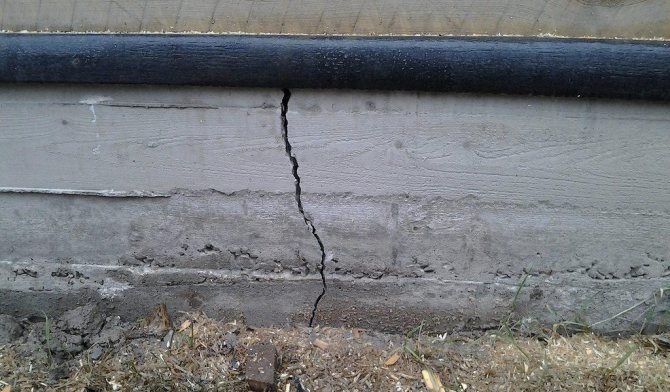
Non-structural structural
The reasons why concrete cracked after pouring can also be plastic shrinkage, reduction of material during the drying process, rusting of reinforcement, and temperature-shrinkage factors.
Acceptable crack opening
The standards SP 28.13330 regulate the complete absence of cracks exclusively in unique structures or in cases where absolute impermeability of the mass is required (gases, liquids under pressure inside). The foundations of cottages do not fall into this category, therefore they are standardized by SP 63.13330 standards. There are several types of cracks in reinforced concrete products, not all of which are dangerous for the performance of the structure:
- hair - got their name from the opening width of 0.1 mm, caused by violations of the outer layer, practically do not affect the strength;
- shrinkage - mainly operational (0.3 mm), geology is not taken into account (loose, weak, unstable, bulk soils);
- horizontal - dangerous for the foundations of heavy buildings, with excessively heaving soils, since they usually cut through the thickness of the structure, after which the operation of the reinforcement frame is disrupted.
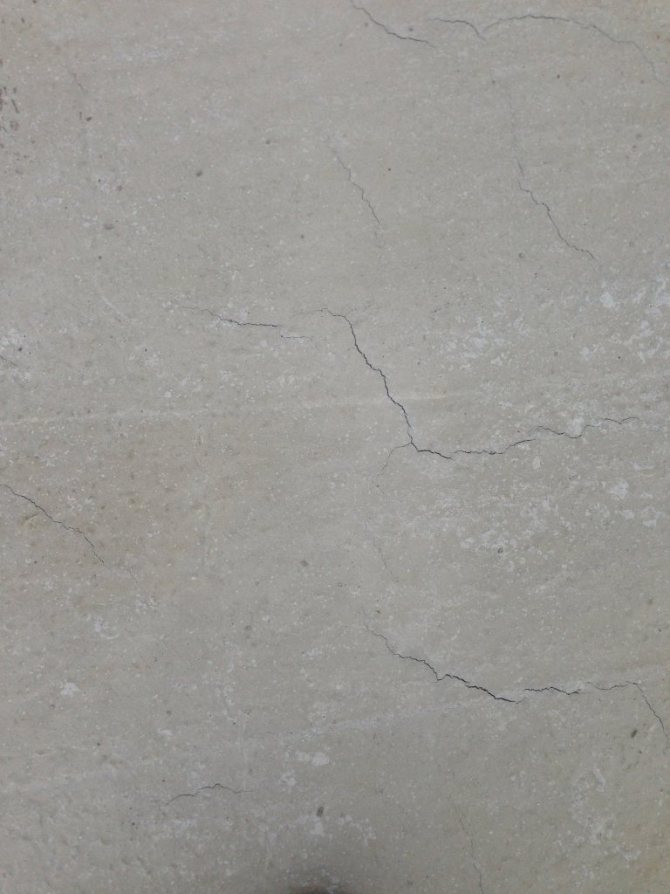
Such cracks often form after pouring; the cause may be poor-quality vibration compaction, dilution of concrete with water, or neglect of concrete care. They usually pose no threat unless they exceed acceptable limits, as shown in the following photo. They are sealed with special repair compounds. They are called shrinkage cracks in concrete (not to be confused with shrinkage of the entire structure under load).
For MZLF it is acceptable if the concrete cracks after pouring within an opening of 0.15 - 0.18 mm (ACI-224), 0.1 mm (GOST 13015) or 0.3 - 0.4 mm (German standards for opening along reinforcement , perpendicular to the working axis, respectively, after pouring).
Methods for eliminating cracking of freshly poured concrete
- Cracks in reinforced concrete that appear before the material begins to set can be eliminated by repeated vibration treatment;
- Cracks that arise during the setting and hardening process are eliminated by rubbing cement (ironization) or repair mortar into the crack;
- The network of cracks that appeared 8 hours after pouring is eliminated using the following method. The surface is cleaned with a metal brush. The resulting cement dust is removed. The surface is treated with a repair compound and, after drying, cleaned again with a brush or foam glass.
Cracks that appear in concrete after complete hardening are eliminated by injection with polyurethane compounds. Injection technology involves supplying special compounds into the crack, which seal the crack and form an elastic “seam”.
The latter effectively restrains further crack propagation under the influence of static and dynamic loads.
Having told in this article why concrete cracks , it is impossible not to mention how to prevent this very harmful process, which ultimately leads to the complete destruction of concrete structures.
- Very often, when mixing the material themselves, inexperienced builders add a large amount of water. This results in strong evaporation and very rapid setting and hardening. The consequence is the formation of shrinkage cracks. In this regard, water must be added in small portions and the recommended consistency of the solution must be observed, even if it seems too thick;
- Concrete structures poured in conditions of high air temperature and bright sunlight must be protected with plastic film, wet cloth or special mats. If this is not possible, the surface of the concrete (at least four times during the day) is generously sprayed with water;
- To avoid the appearance of cracks from soil shrinkage, you should strictly adhere to accepted concrete work technologies: soil compaction, filling with a cushion, laying reinforcing belts, etc.
In any case, before starting concrete work, you should carefully study and strictly follow the theoretical and practical recommendations of GOST and experts on: choice of brand and type of cement, type and type of reinforcement, concrete composition and other features of concrete work.
Nature and location of cracks
Crack opening can occur after application of external loads. Therefore, there is a classification of these defects according to the type of load.
- Connection crack - concrete is destroyed parallel to the rods of the lower and upper chords, the joints of the rods. This is caused by improper anchoring (usually at T-junctions and corners) or by soil compression, uplift from over-watering, or subsidence. In addition, the culprit may be early stripping, loading of fragile concrete with masonry or frame crowns, or insufficient cross-section of reinforcement. With such cracks, there is a danger of the protective layer peeling off.
- Through crack - the culprit is central tension outside the center of the structure.
- Shear crack - usually runs diagonally to the frame rods, occurs due to transverse forces (for example, a pallet with masonry bricks was placed on the tape);
- A bending crack is perpendicular to the axis of the wall and begins at the edge of the stretched zone.
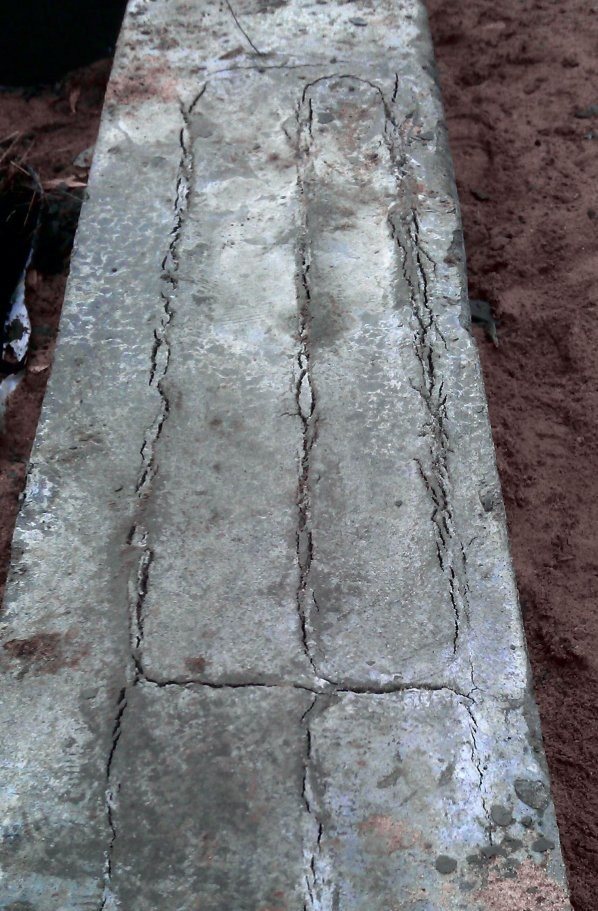
An example of strong shrinkage cracks, such cracks are already dangerous.
Situations often arise when cracks appear on the surface due to internal stresses. The main reason in this option is the significant difference in temperature between the core and the surface of the laid mixture (concreting in the heat, frost + heat released during the chemical reaction of cement with water).
If these stresses exceed the strength of the structural material itself, cracks can open anywhere. They penetrate deep and can close on their own when the temperatures of the layers naturally equalize.
Prevention of thermal stresses - the use of special cements. For example, with a reduced heat of hydration (marked VLH), Portland cement with slag (marked LH). An easier way is to control the temperature of the concrete before laying - within +20 degrees.
What are the types of cracks?
Based on the type of origin, the following types of cracks are distinguished:
- Constructive. They arise from overloads due to design errors, improper operation of the building, and the use of inappropriate grades of cement.
- Unconstructive. They appear due to violations of drying technology and unfavorable conditions for crystallization of solid concrete.
- Created during a fire. Exposure to high temperatures contributes to the formation of delamination of the material due to the expansion of the reinforcement and the large temperature difference between the external and internal layers.
Non-structural cracks are divided into several types:
- Consequence of plastic shrinkage. Caused by the high drying rate of concrete. Outwardly, they look like barely noticeable cracks as thick as a human hair and up to 75 centimeters long.
- Consequences of temperature shrinkage. Crystallization under high temperature conditions causes the appearance of strong stresses that destroy the top layer. The direction of the rupture is from outside to inside. The width of the gaps ranges from tenths of a millimeter to several millimeters; there are cracks that are centimeters wide.
- Corrosion cracks. Formed due to corrosion of reinforcing bars located close to the surface. Most often they are the result of a violation of pouring technology or improper assembly of reinforcement. They appear after several months of use.
It is not always possible to correctly determine why the foundation is cracked. Finding out the reasons for the appearance of gaps helps to establish the nature of the formation and allows us to determine the optimal methods for solving the problem.
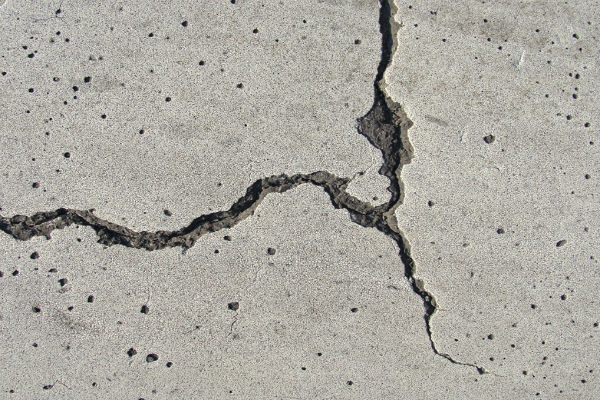
Most of the resulting ruptures are of a non-structural nature and occur on almost all foundations.
The absence of cracks is characteristic of the foundations of special structures of high responsibility, created using special technologies from a specific material. The permissible values of deformations and breaks are clearly defined by SNiP, which regulate the size and depth of possible surface disturbances.
Armature
After laying reinforcement with peeling rust, cracks open after several months or even years. If the protective layer is not observed or the rods are released into the ground (for better support of the clamps), the situation is completely similar to the indicated case.
Aggressive advertising by manufacturers of composite reinforcement is aimed solely at increasing sales volumes. It is strictly not recommended for individual developers to lay it in concrete. For example, manufacturers indicate seamlessness as the main advantage:
- the composite is easy to deliver to the building site in the form of a bay;
- however, excessive plasticity and flexibility leads to unpleasant consequences;
- instead of immediately absorbing tensile loads, the reinforcement is first pulled out;
- this is usually enough to open cracks in the concrete.
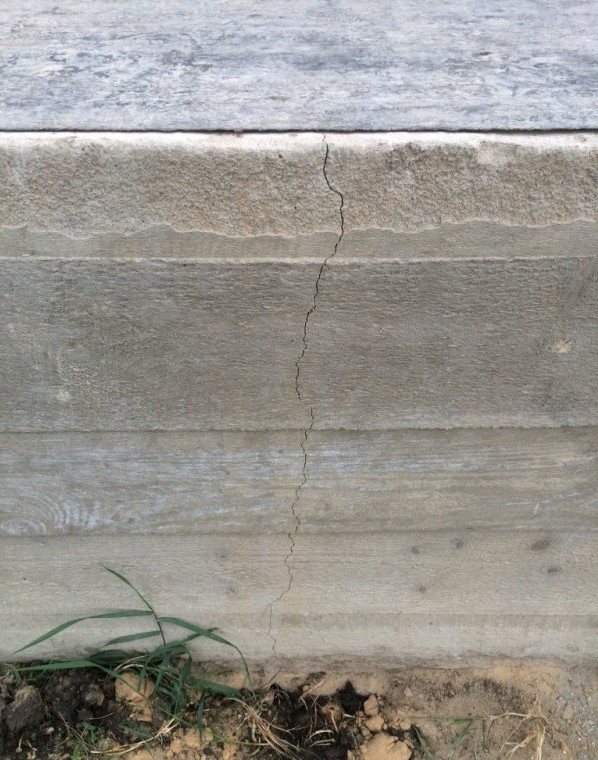
Consequences of using fiberglass reinforcement.
In addition, despite the corrugation, the structure of fiberglass and carbon composite is too smooth, adhesion to concrete components is an order of magnitude lower.
Procedure for repair work
Repairing damage found in structures that have been in use for a long time is carried out according to the following scheme:
- determine the width, depth and nature of the gap, select the appropriate composition for repairing and protecting concrete;
- open the gap, remove crumbled parts of the material, dust, and, if necessary, clean the reinforcement from corrosion;
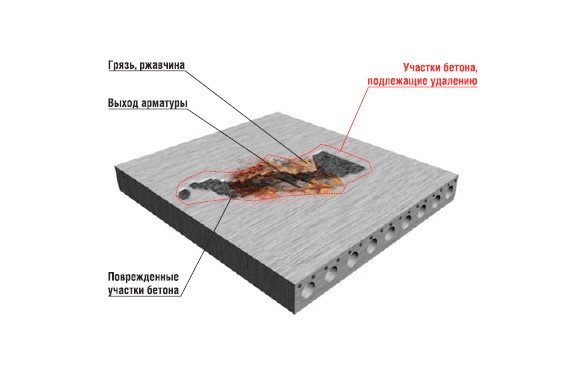
- the cavity is cleaned with an aqueous solution and a brush (sponge, syringe), followed by removal of excess moisture;
- “expand” small cracks until they can be filled, prepare large ones for strengthening. To do this, grooves are made for laying reinforcing wire (diameter of at least 4 mm) across the gap;
- the reinforcement protruding after cleaning the cavity is treated with a special compound to prevent further corrosion;
- coating the surface to be repaired with a primer to improve the adhesion of the repair mixture to the existing composition;
- direct sealing. For extensive and deep damage, it is performed in several stages. If gradual restoration is not possible, standard measures are used to prevent premature drying of the repair composition. How to protect concrete outdoors from destruction to create the required curing conditions is decided depending on the scope of work and weather conditions.
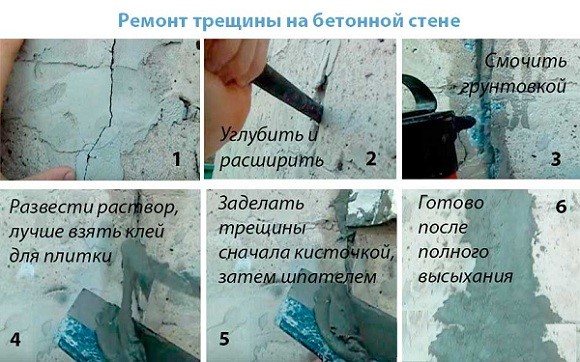
Additionally, you can use a protective coating for concrete to prevent its further destruction and the formation of new damage. As a main function, such coatings provide waterproofing.
There are different types of coatings.
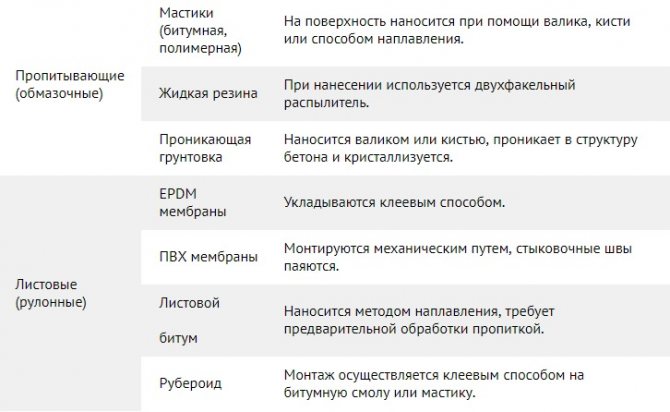
Rubber coating for concrete is one of the most difficult in terms of preparing the solution and using special equipment and equipment for application, but it has excellent performance characteristics and a high degree of waterproofing. Restoration work with rubber coating is especially appropriate for structures that are constantly exposed to atmospheric and ground moisture, including foundations.
Weather
Cracks often appear in concrete after winter concreting, usually in the area of concentration of voids in which water accumulates or along the reinforcement. Measures to combat the defect are high-quality compaction with the tip of a deep-well vibrator until bubbles completely stop, large fillers are hidden, and cement laitance appears (the funnel collapses almost instantly after removing the vibrating tool).
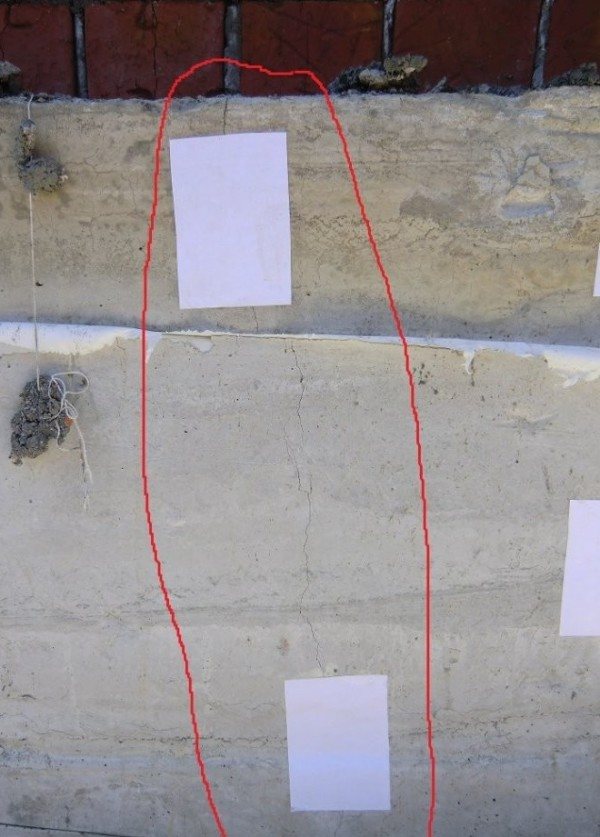
Vertical cracks after wintering indicate incorrect calculations or no geology at all.
The next reason is the accelerated drying of exposed surfaces in the wind, cold or heat. Stresses arise inside the surface layer and cannot be eliminated. Timely and high-quality care of fresh concrete is required.
Cracks in concrete: causes of appearance
To better understand crack repair technologies, it is necessary to consider the types and causes of their occurrence of these defects. Cracks in concrete are classified according to the following factors:
- Depth of damage: hairline, through, superficial.
- Direction of cracks: vertical, inclined, horizontal, curved and closed.
- Type of concrete failure: shear, shear, rupture, collapse.
Reasons why concrete material begins to deteriorate:
- Shrinkage. Shrinkage cracks in concrete are the result of incorrect proportions of components when preparing the solution or improper care of the freshly poured structure. This type of damage appears in the absence of load and is characterized by: a small opening (up to 2 mm), uniform distribution along the entire length of the structure.
- Temperature changes. With a concrete structure length of 100 meters, a change in ambient temperature of 1 degree Celsius causes a change in linear dimensions of approximately 1 millimeter. Due to the fact that temperature changes can reach 15 degrees or more during the day, concrete cracks. To eliminate this harmful phenomenon, the technology of “expansion joints” is used. In this case, the distance between expansion joints is calculated individually depending on the dimensions of the structure and other factors.
- Draft. Uneven settlement of concrete foundations and walls poses a serious danger to newly constructed structures. Settlement is the cause of the most “bad” inclined cracks. To prevent uneven settlement, soil preparation technology should be strictly followed and the building frame should be erected (load the foundation) after natural settlement - 12 months after pouring.
- Heaving. The phenomenon of soil heaving occurs in winter. Frozen soil tries to “push” the building out of the ground, which can result in very serious damage. As practice shows, linear movements of a building as a result of heaving can reach 15 centimeters. The formation of cracks from heaving can be prevented by the correct depth of foundation embedding below the level of maximum soil freezing in a given area.
- Corrosion of steel reinforcement and improper reinforcement. In accordance with the laws of chemistry, the corroded metal increases in volume and accordingly begins to “tear” the concrete. Also, incorrect calculation of the reinforcing belt can lead to the appearance of cracks.
Poor quality raw materials
Cracks may open due to the cement not meeting the declared quality. Individual developers are looking for cheap prices and often do not pay attention to packaging. The bags of a manufacturer that values its reputation must include:
- details - you can conduct an examination, file a complaint, at least partially compensate for the damage;
- packaging period - cement retains its properties under storage conditions for 3 months, after which it begins to “lose” its strength quite sharply;
- ratio of water and filler - for mortars and concretes;
- composition - addition of slag, grinding size significantly influence the hydration process, which is important for the thermal regime of massive structures intended for use in the ground and aggressive environments.
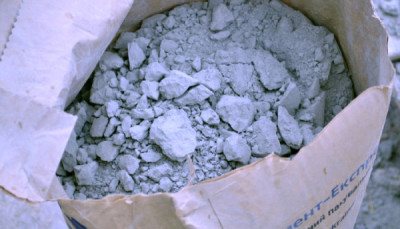
Concrete cracks on the surface immediately after pouring, including due to plastic shrinkage. The principle of this defect is determined by the process of formation of cement stone:
- the volume of the mixture increases with the release of heat as a result of a chemical reaction;
- the surface cools and dries faster and begins to shrink;
- in the core the process lasts more slowly and prevents surface compression;
- the result is cracks across the entire surface or individual sections of concrete.
There is no clear direction, everything depends on the circumstances. Or longitudinal cracks 1–3 mm thick and of insignificant depth appear. A wet compress made from periodically moistened sawdust, sand, and rags completely saves you from these troubles in the first three days.
Damage from plastic shrinkage

Scheme of crack formation due to shrinkage.
This type of damage usually occurs due to intense loss of moisture from the exposed surface of the laid concrete, resulting in uneven shrinkage and compaction of the concrete mass.
This process occurs at the very beginning of setting of the poured concrete mixture. Due to the evaporation of moisture, the surface of the solution actively loses volume, while the middle and bottom layer of laid concrete remain in their original dimensions. The result of this shrinkage is the appearance on the surface of the concrete mixture of a network of small (the width of a human hair) and shallow cracks.
Phenomena similar to those described occur with concrete during precipitation. When it rains, the surface of the concrete gets wet, and a certain amount of moisture gets inside the monolith. When the rain stops and the sun comes out, the wet surface of the concrete heats up, expanding, and cracks may appear on it.
This type of damage also includes cracks that appear in concrete under the influence of gravity. The reason for the appearance of such cracks is insufficient compaction of the concrete being laid. In this case, the following results: the forces of gravity act on the setting concrete monolith, and if insufficiently compacted areas remain in its body, then the mixture in these areas will continue to compact, breaking the integrity of the concrete monolith.
Dilution with water
When ordering the mixture using mixers, developers sometimes receive delivery times of one and a half hours. After laying the first layer, time is required for compaction by vibration. Another 1 - 1.5 hours pass, the concrete begins to thicken, water is added to it.
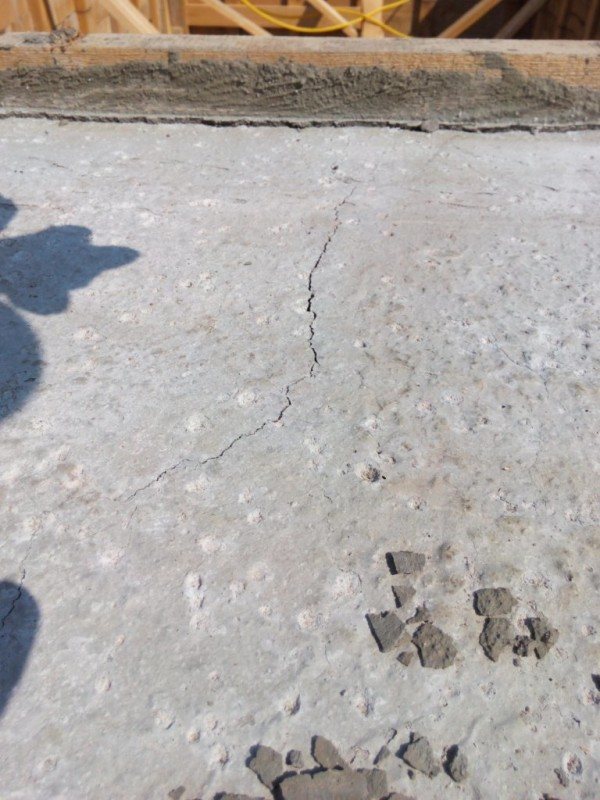
Large shrinkage crack turning into a vertical one. When the concrete is heavily diluted with water and a vibrator is not used, this also happens.
In this case, cracks are inevitable, since the proportions balanced by the mortar unit are disrupted. Grade strength decreases, hydration time increases (water-cement ratio W/C increases).
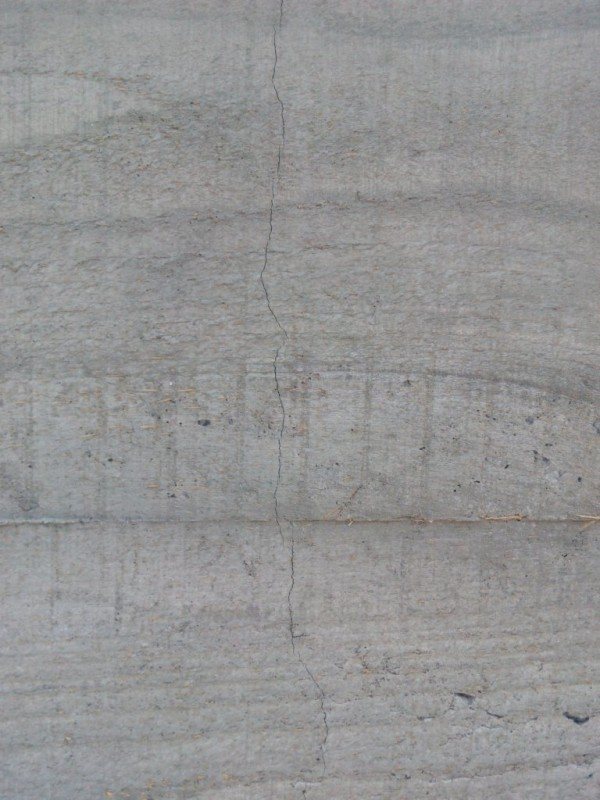
Side view of the top crack.
Methods for sealing cracks in concrete elements
Cracks that appear in fresh concrete can be eliminated using one of the proposed methods.
- If cracks appear in fresh concrete before it begins to harden (within 1-2 hours after mixing the components), then they can be eliminated by repeated vibration.
- If cracks appear during the drying process, they can be eliminated by rubbing cement or a special repair mortar into the cracks.
- If grid-shaped cracks appear approximately 8 hours after hardening, they can be repaired as follows. The surface is cleaned with a piece of foam glass or a brush. Dust is removed from the surface of the concrete element with a brush or air jet. The cleaned concrete layer is treated with cement repair compounds. After they harden, the surface is re-rubbed with foam glass or a brush.
"Long Run"
Downtime of mixers is expensive for the developer, so concrete is often dumped in one place and shoveled to distant areas without a tray. This leads to the separation of the mixture into separate fractions - large crushed stone is better captured by the entrenching tool, the liquid practically remains in place.
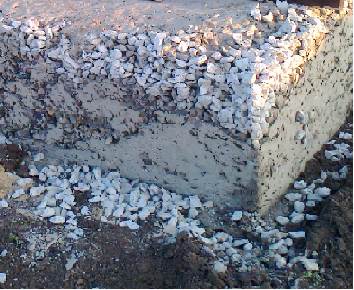
Pronounced consequences of concrete delamination.
The result is an uneven concentration of sand/crushed stone in individual areas, which cannot but affect the quality. There will be no design strength in any section of such a foundation, crushed stone is physically unable to envelop the reinforcement, cracks are inevitable.
Exceeding the technological break
The recommended technological break is 1 - 2 hours, depending on the specific pouring conditions, due to the hydration time. If the next portion is laid after the specified time on the previous layer, the tip of the deep vibrator will destroy the formed bonds without the possibility of their restoration.
In addition, a large volume of concrete on the surface of the previous layer will push through the emerging structure, which will lead to the formation of cracks and a loose consistency incapable of absorbing loads.
What to do to prevent concrete from cracking
It is impossible to avoid the occurrence of cracks once they have already appeared. It is necessary to understand the physical meaning of the appearance of discontinuities. The peculiarity of the phenomenon is the latent mode of crack formation.
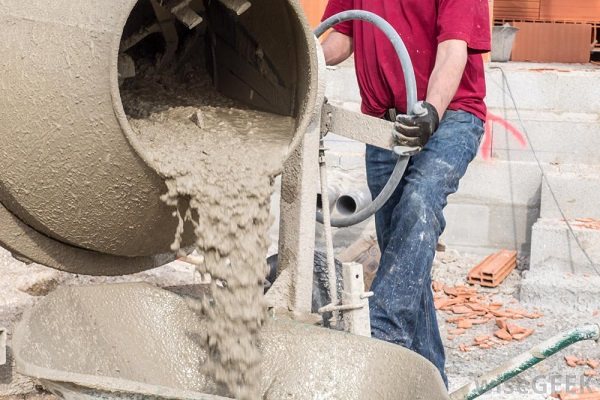
Their occurrence can only be prevented in advance by using the correct technological methods, using appropriate materials, and carrying out work in favorable climatic and temperature conditions.
The technology for preparing the mortar requires the use of appropriate quantities of sand, cement and filler. Exceeding the concentration of the binder contributes to the formation of microcracks, which are dangerous due to their quantity and invisibility.
Crystallizing concrete must be moistened with water. The surface receives moisture, the volume of the outer layers is equalized relative to the inner ones, which did not have time to release water. The drying process is accompanied by the release of heat; on hot summer days, wetting should be done 2-3 hours after pouring.
You cannot spray water from a hose with a direct stream under pressure; you must use a watering can or sprinkler. The optimal watering regime in the first week after pouring is once every 3-4 hours, over the next week - 1-2 times a day. The wetted surface is covered with plastic film and rubberized cloth.
Pouring concrete must necessarily be accompanied by periodic bayoneting and compaction of the mass. Eliminating cavities and bubbles inside the solution will avoid the appearance of deformation stresses that cause rupture of the surface layers.
